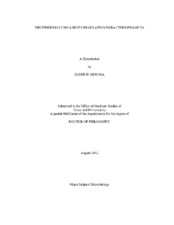| dc.description.abstract | Like all phages, T4 requires a holin (T) to effect lysis. The lysis event depends on the temporally regulated action of T, which accumulates in the inner membrane (IM) until, at an allele-specific time, it triggers to form a large "hole" in the membrane. Hole formation then releases T4 lysozyme into the periplasm where it degrades the cell wall to elicit cell lysis. Unlike other phages, T4 is unique in exhibiting real-time regulation of lysis based on environmental conditions. Specifically, lysis can be delayed indefinitely in the lysis-inhibited state (LIN), where the normal temporal schedule for holin-triggering is over-ridden. Recently, it was shown that the imposition of LIN was correlated with the interaction of the periplasmic domains (PD) of RI and T. These studies have been extended in this dissertation using genetic, biochemical, and structural techniques to address the molecular mechanism of the RI-T LIN system.
First, the PD of RI and an RI-T complex were purified, characterized biophysically, and crystallized to yield the first atomic resolution structures of either a holin or antiholin. The RI PD is mostly alpha-helical that undergoes a conformational change, as revealed by NMR spectroscopy studies, when bound to T. The PD of T is globular with alpha-helical, beta strand, and random coil secondary structures.
Additionally, the holin was genetically characterized by mutagenesis techniques, yielding new information on its role in both lysis and LIN. Lysis defective mutants in all three topological domains: cytoplasmic, transmembrane, and periplasmic, were isolated. Analysis of these mutants revealed that both the cytoplasmic and periplasmic domains are important in the oligomerization of T. During LIN, the RI PD binds the PD of T, blocking a holin oligomerization interface.
Finally, the signal for the imposition of lysis inhibition has been elucidated using NMR spectroscopy and other in vitro studies. These studies have shown that the RI PD binds DNA.
From these studies, new models for lysis and LIN have been constructed. Lysis occurs with the accumulation and oligomerization of T via cytoplasmic and periplasmic domain interactions. LIN is imposed when the ectopically localized DNA of a superinfecting phage interacts with RI, stabilizing it in a conformation competent in inhibiting T oligomerization and leading to lysis inhibition. | en |


